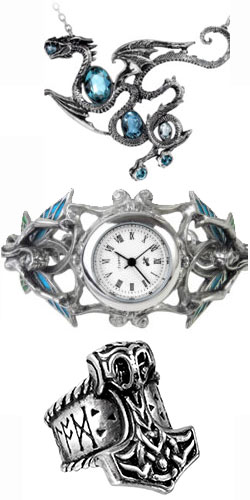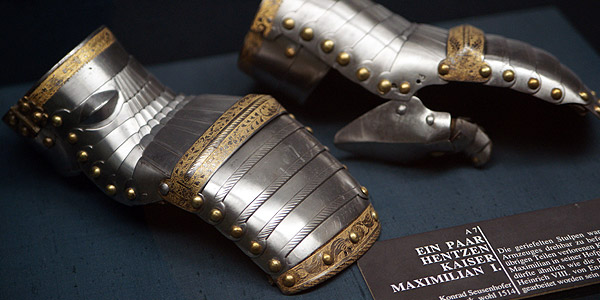How to Dress Renaissance
The Evolution of Medieval Gauntlets

Gauntlets are pieces of armor that protect the hands and wrists. The word “gauntlet” is derived from the ancient French word, “gant,” meaning glove.
Medieval gauntlets were the most sophisticated parts of the full plate of metal armor that evolved by the late medieval time period in the 15th and 16th centuries. By this time, gauntlets had evolved to be highly complex and fully articulated. Each finger had an assemblage of small gutter-shaped metal plates called lames that allowed for free movement of the fingers. These late medieval gauntlets were nothing less than a technological marvel. However, they did not start out this way. This post will summarize the fascinating evolution of medieval gauntlets.
There is evidence that Greek warriors wore some protection for the back and sides of their hands. However, this Greek armor was never developed into full gauntlets and there is a period of several centuries, including most of the early medieval time period, where soldiers wore no protection on their hands. It is believed by most historians that this type of protective equipment was deemed unnecessary as long as a shield was carried in the non-dominant hand. However, this began to change when the shield fell out of favor as two-handed swords became popular.
The extra force of using a two-handed sword had many advantages over a one-handed sword, as armor was rapidly improving during this period and it took a lot more force to penetrate it. However, eliminating the shield left the hands particularly vulnerable and opponents often seized on this weakness. A solution had to be found. During this period, some men simply wore leather wrapped around their hands. Others wore more skillfully crafted leather gauntlets.
Most early medieval infantry wore a tunic made of small interlocking metal rings called mail. Starting in the last three decades of the 12th century, the sleeves of the hauberk were elongated into a mitten to protect the hands. A leather glove was worn beneath this mail mitten to protect the skin from injury from the metal. This style of hand protection took a while to catch on fully, as many infantry simply wore leather gauntlets. However, once it caught on, the extension of the hauberk into a mail mitten with a leather glove worn beneath it was the prevalent hand protection for more than a century and a half.
At the end of the 13th century, a slit in the palm of the attached mail mitten began appearing, so the hand could pass through and leave the mail mitten dangling at the wrist. During this same period, mail gloves with separate fingers started appearing, still an extension of the sleeve. During the first half of the 14th century, separate mitten gauntlets and glove gauntlets start appearing for the first time. This was in part due to the fact that mail hauberks were being replaced by plate armor. Some of these early separate gauntlets were made of mail but many are made of leather with metal pieces attached. These were the earliest examples of metallic plates being used on gauntlets but they were not yet articulated. In essence, these were the prototypes of the articulated metal gauntlets so common in the 16th century.
Metal plated gauntlets lined with leather were considered a huge improvement over mail mittens and mail gloves. Therefore, they caught on very quickly and within just a few decades, they had replaced almost all the mail mittens and mail gloves. Like other parts of the coat of plate armor, the metallic plates used on gauntlets were riveted to leather. At first, the lames were cut in strips to cover all the fingers, like a mitten made with plate. Each lame was individually riveted to the leather beneath so that articulation could occur and the hand could wrap around a sword. During the second half of the 14th century, the style was for the metal on the back of the hand and the palm of the hand to taper in around the wrist and then flair out over the lower forearm. This style was called the hour glass gauntlet and it remained very popular for more than 50 years. The cuff was often decorated.
Plated mitten style gauntlets did offer more protection than early glove style gauntlets that allowed the articulation of each finger separately. However, they also offered less dexterity so individual finger articulation was preferred as it was developed. Eventually, the process of articulating each finger, not just the thumb, was fine-tuned to the point that the plate fingered gauntlets became as good at protecting the hands as the plate mitten gauntlets were.
The individual lames for each finger on fingered gauntlets were made by first cutting out the metal and then pounding it into a gutter shape against a mould. Then small holes were drilled into each lame and they were then separately riveted to the leather through these holes. The piece of metal that covers the back part of the thumb was attached to the back plate of the gauntlet with a hinge, allowing for the opposable thumb to abduct.
It should be noted that even though the technology to make full body suits of articulated metal plate armor existed in the 14th and 15th centuries, most infantry could not afford it. Moreover, the countries for which they fought could not afford to outfit most of their infantry men with full body armor. When they could afford it, chest plates and fully articulated metal gauntlets were the most sought after pieces of equipment during this time period. Hands had to be protected above almost all other parts of the body since they were so easily injured and were also very important in the efficiency of a soldier. Also, noble knights, who fought mostly on horseback, wore full suits of armor during this time, so there was quite a demand for exceptionally skilled artisans who could master the trade of fine-tuned articulation in making gauntlets.
Modern day groups interested in medieval history, like the Society For Creative Anachronisms (SCA), reenact historic medieval battles. These groups make their own armor and their own weapons. They strive for as accurate a replication as possible. However, even with modern tools plus a great deal of experience and skill, it can still be difficult to build a pair of fully-articulated plate gauntlets that work properly. The difficulty lies in getting the articulation of each lame and the thumb to work in perfect synchrony. If the holes drilled on each lame for the purpose of riveting them to the leather are off by even a millimeter, they may not articulate in perfect synchrony when the hand is clenched around the sword or other tools. In a real battle, this could mean the difference between life and death.
Full plate late medieval gauntlets were a technological marvel at the time and they still are today when you think about the tools and materials those medieval artisans had to work with. It took a great deal of skill to create a fully functioning pair that were perfectly articulated. Those that have tried to re-create these period pieces understand this best. The next time you see late medieval armor in a museum or a medieval painting showing men in armor, take the time to look closely at the medieval gauntlets as they are truly a mechanical work of art.
Cindy
Ye Old Renaissance Shop


